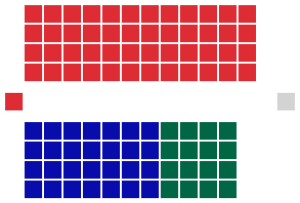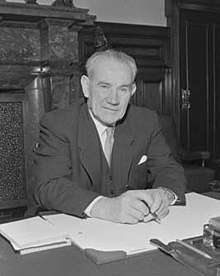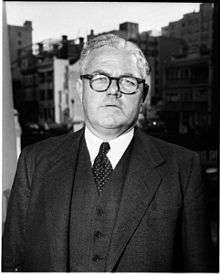1959 New South Wales state election
The 1959 New South Wales state election was held on 21 March 1959. It was conducted in single member constituencies with compulsory preferential voting and was held on boundaries created at a 1957 redistribution. The election was for all of the 94 seats in the Legislative Assembly.
| |||||||||||||||||||||||||||||||
All 94 seats in the New South Wales Legislative Assembly 48 Assembly seats were needed for a majority | |||||||||||||||||||||||||||||||
|---|---|---|---|---|---|---|---|---|---|---|---|---|---|---|---|---|---|---|---|---|---|---|---|---|---|---|---|---|---|---|---|
| |||||||||||||||||||||||||||||||
 Legislative Assembly after the election | |||||||||||||||||||||||||||||||
| |||||||||||||||||||||||||||||||
Redistribution
A redistribution of electoral boundaries was undertaken in 1957 based on the 1954 Australian Census. Reflecting population shifts from the eastern and inner western suburbs of Sydney to western Sydney, two safe Liberal seats, Ashfield and Croydon were combined into the seat of Ashfield-Croydon and two safe Labor seats, Paddington and Waverley were combined into Paddington-Waverley. Merrylands was created in Western Sydney and was a notional Labor seat. In addition, the marginal seat of Parramatta became a safe Labor seat. In southern Sydney, the marginal seat of Sutherland became a safe Labor seat by the creation of Cronulla which had a notional Liberal majority. The effect of the redistribution was to increase Labor's numbers by 1.
Issues
In March 1959, Labor had been in power for 18 years and Joseph Cahill had been premier for 7 years. Cahill, who was commonly known as "old smoothie" continued to be a popular premier but the opposition campaign argued that his cabinet consisted of "tired old men". While nationally the Labor party remained divided on sectarian and ideological grounds, in New South Wales much of the split between Labor and the DLP had been avoided. Clive Evatt, the brother of H V Evatt, who had been the major left-wing agitator within the caucus was expelled from the party after he voted against a government move to increase tram fares. As a result, party unity was significantly improved. However, a small branch of the DLP under the leadership of Jake Kane had organised in NSW and nominated candidates at this election for the first time.
Cahill attacked the opposition for its "reckless election promises" which were "worth no more than a handful of Bondi sand" .[1] Labor promised, that if re-elected, it would form a Commonwealth- State Housing Corporation to lend up to 95% of housing costs on a 45-year basis. It would attempt to reduce road taxes for haulage companies and promised a vigorous program of road development including the possible use of privately constructed toll roads. Cahill announced plans to build Housing Commission towers in Surry Hills and promised a referendum on the abolition of the New South Wales Legislative Council.[2]
The coalition of the Liberal Party and the Country Party coalition had been led by Pat Morton since September 1955. However, Morton remained a somewhat aloof figure, with a public presence more typical of pre-war conservative politicians, and found it difficult to connect with the public. Davis Hughes, who had led the Country Party since September 1958 was forced to resign the leadership at the start of the campaign when it was revealed that he had falsely claimed to have a university degree. He was replaced by Charles Cutler.
The opposition campaigned on the government's broken promises and its continuing record of over-budget and uncompleted public works. In addition it promised to abolish several taxes including; land tax and the road maintenance tax. School transport would be free and the number of high school bursaries increased. Sewering the outer western suburbs, with a deep sea discharge, and completing the Sandy Hollow railway line were the opposition's public works priorities. The housing crisis was to be resolved by the government construction of 100,000 houses in 3 years [1] .[3]
Results
The result of the election showed little change but was a clear victory for Labor with a buffer of 2 seats in the parliament:
- Australian Labor Party 49 seats
- Liberal 28 seats
- Country Party 16 seats
- Independent 1 seat
Labor regained the seat of Hurstville from Clive Evatt who had sat as an Independent Labor member since his expulsion from the party. It had already reclaimed Kahibah at a by-election caused by the death of the Independent Labor Member Tom Armstrong. However Labor failed to take back the usually safe seat of Waratah from Frank Purdue. As expected Labor won Parramatta, Sutherland and Merrylands but lost Dubbo, Cronulla and Blacktown to the Liberals. It had already lost the seat of Wagga Wagga at a by-election caused by the death of Eddie Graham. Labor also lost Young to the Country Party.
The DLP performed poorly, finishing behind the Communist party with less than 2% of the vote.
Seats changing party representation
This table lists changes in party representation since the 1956 election
| Seat | Incumbent member | Party | New member | Party | ||
|---|---|---|---|---|---|---|
| Ashfield | Richard Murden | Liberal | Abolished absorbed into Ashfield-Croydon | |||
| Ashfield-Croydon | New seat | David Hunter | Liberal | |||
| Blacktown | John Freeman | Labor | Alfred Dennis | Liberal | ||
| Cronulla | New Seat | Ian Griffith | Liberal | |||
| Croydon | David Hunter | Liberal | Abolished absorbed into Ashfield-Croyden | |||
| Dubbo | Clarrie Robertson | Labor | Les Ford | Liberal | ||
| Kahibah | ‡ | Independent Labor | Jack Stewart | Labor | ||
| Merrylands | New Seat | Jack Ferguson | Labor | |||
| Paddington | Maurice O'Sullivan | Labor | Abolished absorbed into Paddington-Waverley | |||
| Paddington-Waverley | New Seat | William Ferguson | Labor | |||
| Parramatta | James Clough | Liberal | Dan Mahoney | Labor | ||
| Sutherland | Ian Griffith | Liberal | Tom Dalton | Labor | ||
| Wagga Wagga | ¶ | Labor | Wal Fife | Liberal | ||
| Waverley | William Ferguson | Labor | Abolished absorbed into Paddington-Waverley | |||
| Young | Fred Cahill | Labor | George Freudenstein | Country | ||
‡ Labor won the seat of Kahibah at a 1957 by-election caused by the death of the Independent Labor member Tom Armstrong
¶ The Liberal Party won the seat of Wagga Wagga from Labor at a 1957 by-election caused by the death of Eddie Graham
Key dates
| Date | Event |
|---|---|
| 16 February 1959 | The Legislative Assembly was dissolved, and writs were issued by the Governor to proceed with an election. |
| 20 February 1959 | Nominations for candidates for the election closed at noon. |
| 21 March 1959 | Polling day. |
| 16 April 1959 | Last day for the writs to be returned and the results formally declared. |
| 21 April 1959 | Opening of 39th Parliament. |
Tabulated results
|
New South Wales state election, 21 March 1959[4] | ||||||
|---|---|---|---|---|---|---|
| Enrolled voters | 2,075,268[lower-alpha 1] | |||||
| Votes cast | 1,739,580 | Turnout | 94.00 | +0.73 | ||
| Informal votes | 31,864 | Informal | 1.83 | +0.16 | ||
| Summary of votes by party | ||||||
| Party | Primary votes | % | Swing | Seats | Change | |
| Labor | 838,836 | 49.12 | +1.87 | 49 | −1 | |
| Liberal | 603,718 | 35.35 | −0.74 | 28 | +1 | |
| Country | 148,738 | 8.71 | −1.45 | 16 | +1 | |
| Independent | 61,939 | 3.63 | +0.50 | 1 | − | |
| Communist | 24,784 | 1.45 | −0.29 | 0 | − | |
| Democratic Labor | 22,508 | 1.32 | +1.32 | 0 | − | |
| Independent Labor | 7,193 | 0.42 | −1.46 | 0 | −1 | |
| Total | 1,707,716 | 94 | ||||
Aftermath
Joseph Cahill died in October 1959 and was replaced by Robert Heffron who continued as Premier for the rest of the term. Pat Morton was replaced as Leader of the Opposition in July 1959 by Robert Askin. Charles Cutler remained Leader of the New South Wales Country Party throughout the term of the parliament. During the parliament there were 6 by-elections with Labor and the Country Party each winning a seat at the other party's expense.
See also
Notes
- There were 1,850,675 enrolled voters in 83 contested electorates and 224,593 were enrolled in 11 uncontested electorates (1 Labor, 5 Liberal and 5 Country ).[4]
References
- "Morton promises like Bondi beach sand". The Sydney Morning Herald. 3 March 1959. p. 4.
- "Labor Plan for 95% home purchase loans". The Sydney Morning Herald. 25 February 1959. p. 1.
- McMullin, Ross (1991). The Light on the Hill: The Australian Labor Party 1891-1991. Oxford University Press. ISBN 0-19-554966-X.
- Green, Antony. "1959 election totals". New South Wales Election Results 1856-2007. Parliament of New South Wales. Retrieved 12 August 2019.

